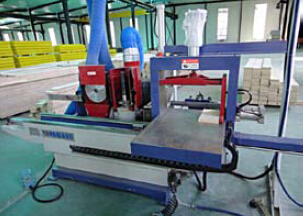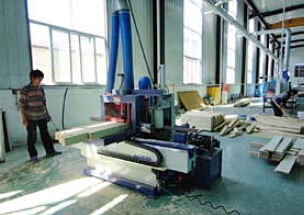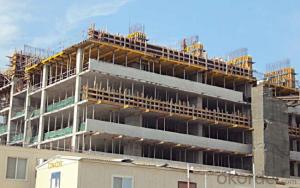Timber-beam Formwork H20 for formwork and scaffolding system
- Loading Port:
- Tianjin
- Payment Terms:
- TT OR LC
- Min Order Qty:
- 50 m²
- Supply Capability:
- 1000 m²/month
OKorder Service Pledge
Quality Product, Order Online Tracking, Timely Delivery
OKorder Financial Service
Credit Rating, Credit Services, Credit Purchasing
You Might Also Like
Characteristics:
◆ Standardized production lines.
Supply capability: 3000m/day, Lmax = 6600mm.
◆ Finger jointing of the flange and web, the strength of timber beam is highly improved.
Max. shearing force failure load:40KN
◆ Well treated to prevent from water penetration or erosion, so the service life maximally
extended.
Normally, CNBM timber beam H20 can be used for 4 to 5 years, the exact using time would
depend on maintenance & storage.
◆ Robust caps at the end of the girders protect against damages.




- Q:Are there any specific building codes or regulations related to steel formwork?
- Steel formwork is subject to specific building codes and regulations that are in place to ensure the safety, stability, and integrity of structures built with this material. The International Building Code (IBC) is one well-known code that sets out minimum requirements for the design, construction, alteration, and maintenance of buildings and structures. It includes provisions for formwork systems, including steel formwork, to ensure they meet standards of strength, durability, and stability. Other organizations and agencies also provide guidelines and standards for steel formwork. For instance, the American Concrete Institute (ACI) has a document called ACI 347-04, Guide to Formwork for Concrete, which offers recommendations for the use of different types of formwork, including steel formwork. These codes and standards cover various aspects of steel formwork, such as design, materials, construction, and inspection. They address issues like maximum allowable loads, proper bracing and shoring, formwork connections, and material quality. They also provide guidance on safety measures, including fall protection, to ensure the well-being of workers during formwork installation and removal. Builders, designers, and contractors must familiarize themselves with these codes and regulations to ensure compliance and guarantee the structural integrity and safety of buildings constructed with steel formwork. Local building departments and authorities having jurisdiction can provide specific information and requirements related to steel formwork in their respective regions.
- Q:Can steel formwork be used for bridge construction?
- Yes, steel formwork can be used for bridge construction. Steel formwork offers several advantages such as high strength, durability, and reusability, making it suitable for constructing bridge components like beams, columns, and decks. It provides a stable and rigid structure that can withstand heavy loads and adverse weather conditions, ensuring the safety and longevity of the bridge.
- Q:Can steel formwork be used for architectural construction projects?
- Yes, steel formwork can be used for architectural construction projects. Steel formwork offers several advantages such as durability, versatility, and reusability, making it a suitable choice for various architectural applications. It provides a strong and rigid structure that can withstand the concrete pressure during casting, allowing for the creation of complex shapes and designs. Additionally, steel formwork can be easily assembled, dismantled, and adjusted, enabling efficient construction processes and reducing overall project timelines.
- Q:Can steel formwork be used for precast concrete facades with intricate patterns?
- Absolutely! Precast concrete facades with intricate patterns can indeed utilize steel formwork. Renowned for its robustness and longevity, steel formwork proves ideal for fashioning elaborate and meticulous designs. The adaptability of steel enables the crafting of intricate patterns, textures, and contours on the concrete surface. Moreover, steel formwork can be effortlessly tweaked and altered to accommodate any desired pattern or design, rendering it a favored option for precast concrete facades that demand intricate patterns or artistic elements. Ultimately, steel formwork offers the vital support and flexibility necessary to accomplish intricate designs in precast concrete facades.
- Q:How does steel formwork affect the overall seismic performance of a structure?
- There are several ways in which the overall seismic performance of a structure can be significantly affected by steel formwork. To begin with, during the construction process, steel formwork acts as a rigid and robust temporary support system. This ensures that the concrete is aligned and placed correctly, which is vital for the structural integrity of the building. By providing precise formwork, steel helps in creating a well-designed structure that can withstand seismic forces. Furthermore, the strength and stiffness of the concrete structure are enhanced by steel formwork. Steel is renowned for its high tensile strength, enabling it to resist the lateral forces caused by earthquakes. This increased strength and stiffness can help reduce deformation and damage caused by seismic activities. Additionally, steel formwork can prevent crack formation and improve the durability of the structure as a whole. In addition, steel formwork contributes to the ductility of a building. Ductility refers to a structure's ability to undergo significant deformations without sudden failure. Steel formwork allows for the creation of reinforced concrete elements, such as beams and columns, which can absorb and dissipate seismic energy through plastic deformations. This plastic behavior aids in redistributing seismic forces and reducing the structure's overall vulnerability. Moreover, steel formwork facilitates the use of innovative structural systems like steel plate shear walls, moment frames, or braced frames. These systems are designed to enhance seismic resistance by dissipating energy and controlling deformations during earthquakes. Steel formwork enables precise fabrication and installation of these systems, ensuring their effectiveness in improving the structure's seismic performance. In conclusion, steel formwork is crucial in enhancing the overall seismic performance of a structure. It provides temporary support, enhances concrete strength and stiffness, improves ductility, and enables the use of innovative seismic-resistant systems. By incorporating steel formwork in the construction process, engineers can create structures that are better equipped to withstand the destructive forces of earthquakes.
- Q:What are the different types of steel used in formwork construction?
- There are several types of steel commonly used in formwork construction, including mild steel, high-strength low-alloy steel (HSLA), and high-strength steel. Additionally, stainless steel may be utilized in specific applications where corrosion resistance is required. The choice of steel type depends on factors such as the desired strength, durability, and cost-effectiveness of the formwork system.
- Q:How does steel formwork contribute to the overall strength and stability of a structure?
- The construction industry heavily relies on steel formwork to enhance the strength and stability of structures. This crucial component plays a vital role in maintaining the integrity and durability of buildings by providing a dependable support system during the process of pouring concrete. To begin with, steel formwork possesses exceptional strength and rigidity, enabling it to withstand the immense weight and pressure exerted by wet concrete. Its sturdy construction ensures that it does not deform or collapse under these heavy loads, thereby preventing any potential damage or compromise to the stability of the structure. Furthermore, steel formwork provides an accurate and precise framework for pouring concrete. The dimensional stability of steel ensures that the formwork retains its shape and dimensions throughout the construction process. This accuracy is crucial in achieving a structurally sound and level structure, as any misalignment or irregularity in the formwork can lead to uneven distribution of concrete and weaken the overall strength of the building. Moreover, steel formwork exhibits excellent resistance to moisture and corrosion. This resistance guarantees that the formwork remains intact and structurally sound, even in environments with high humidity or exposure to water. By preventing rust and deterioration, steel formwork maintains its strength and stability over time, thus contributing to the long-term durability of the structure. Another notable advantage of steel formwork is its reusability. Unlike traditional wooden formwork, steel formwork can be reused multiple times without compromising its structural integrity. This reusability not only reduces construction costs but also minimizes waste and environmental impact. The ability to reuse steel formwork ensures that subsequent concrete structures maintain consistent strength and stability, without any compromise in quality. In conclusion, steel formwork is an indispensable element in the construction industry, significantly enhancing the strength and stability of structures. Its exceptional strength, dimensional accuracy, resistance to moisture and corrosion, and reusability make it an ideal choice for ensuring the integrity and durability of concrete structures. By providing a robust and reliable support system, steel formwork plays a pivotal role in the construction of safe and long-lasting buildings.
- Q:How does steel formwork handle different concrete testing procedures?
- The construction industry favors steel formwork because of its durability and versatility. When it comes to concrete testing, steel formwork proves highly capable and efficient. To begin with, steel formwork can withstand the pressure and weight exerted by concrete during various testing procedures. Regardless of whether it's a compression test, slump test, or any other form of concrete testing, the robustness of steel formwork guarantees it remains intact and does not deform under the load. In addition, steel formwork provides a smooth and even surface for concrete testing. This is crucial for obtaining accurate test results since any irregularities or inconsistencies in the formwork can impact the quality and integrity of the concrete sample being tested. Steel formwork is renowned for its precision, ensuring the concrete is poured and shaped precisely as required for each specific testing procedure. Furthermore, steel formwork is adaptable and easily modified to accommodate different concrete testing procedures. It can be adjusted or reconfigured to meet the specific requirements of various tests, such as creating different shapes, sizes, or depths for concrete samples. This flexibility allows for efficient and accurate testing, as the formwork can be customized according to the testing procedure being carried out. Moreover, steel formwork is reusable, providing cost-effectiveness and sustainability in concrete testing. Unlike other types of formwork that may need to be discarded after a single use, steel formwork can be dismantled, cleaned, and reused multiple times. This reduces overall expenses associated with concrete testing procedures and minimizes waste generation, making it an environmentally friendly option. In conclusion, steel formwork is well-suited for handling different concrete testing procedures due to its strength, precision, adaptability, and reusability. It offers a stable and consistent surface for accurate testing, ensuring reliable results. With its numerous advantages, steel formwork remains the preferred choice in the construction industry for various concrete testing requirements.
- Q:How does steel formwork perform in seismic-prone areas?
- Due to its inherent strength and durability, steel formwork performs exceptionally well in seismic-prone areas. Unlike timber or plywood formwork, steel formwork offers superior resistance to seismic forces, providing a rigid and stable structure capable of withstanding lateral forces generated during an earthquake. One of the main advantages of using steel formwork in seismic-prone areas is its ability to maintain structural integrity and stability. The high tensile strength of steel enables it to resist the powerful shaking and ground motions associated with seismic activity. As a result, steel formwork is less likely to deform, crack, or collapse during an earthquake, ensuring the safety of both the structure and the construction workers. Additionally, steel formwork possesses excellent load-bearing capacity, which is crucial in seismic-prone areas. The formwork system provides robust support to the concrete during casting and curing, ensuring the structure remains intact even under dynamic loading conditions. This ability to withstand heavy loads is particularly important in earthquake-resistant design, as it helps prevent structural failure and the resulting loss of life and property. In addition to its strength, steel formwork offers other advantages in seismic-prone regions. It is highly reusable, durable, and resistant to moisture, making it ideal for construction projects in areas with high seismic activity. The reusability of steel formwork reduces construction waste and allows for long-term cost savings. Furthermore, steel formwork is versatile and adaptable, making it suitable for various structural applications in seismic-prone areas. It can be easily customized to fit different shapes and sizes, facilitating the efficient construction of complex structures. This flexibility is crucial in earthquake-resistant design, where the formwork must conform to specific architectural and structural requirements. Overall, steel formwork is an excellent choice for construction in seismic-prone areas. Its strength, durability, load-bearing capacity, reusability, and adaptability make it a reliable and efficient solution for withstanding the forces exerted by earthquakes. By utilizing steel formwork, construction projects can enhance the safety and resilience of structures in regions prone to seismic activity.
- Q:How does steel formwork affect the overall efficiency of the construction process?
- The overall efficiency of the construction process can be greatly enhanced through the utilization of steel formwork, primarily due to its durability, versatility, and ease of use. To begin with, the strength of steel formwork is exceptional, enabling it to withstand the weight and pressure of concrete without bending or warping. Consequently, construction can be expedited, as there is no need to wait for repairs or replacements to be made to the formwork. Additionally, the ability to reuse steel formwork multiple times reduces the time and cost associated with constantly purchasing new materials. Furthermore, steel formwork is highly adaptable and can be easily customized to meet the specific requirements of different construction projects. It can be effortlessly adjusted, cut, and welded to create a variety of shapes and sizes, thereby allowing for greater design flexibility. This adaptability also facilitates quicker construction, as the formwork can be swiftly modified to accommodate changes in the construction plans. Moreover, steel formwork is designed with user-friendliness in mind, making assembly and dismantling easier and faster for construction workers. Compared to materials such as wood or aluminum, steel formwork is lightweight, reducing the physical effort required during installation and removal. The standardized components of steel formwork also contribute to a more efficient and less time-consuming assembly process. Additionally, the use of steel formwork improves quality control and accuracy in construction. The smooth surface of steel formwork ensures a consistent finish on concrete structures, minimizing the need for additional finishing work. This not only saves time but also enhances the overall aesthetics of the construction project. In conclusion, the utilization of steel formwork significantly enhances the efficiency of the construction process by reducing construction time, minimizing material waste, and improving the quality and accuracy of the final structures. Its durability, versatility, and ease of use make it an ideal choice for construction projects of all sizes.
1. Manufacturer Overview |
|
|---|---|
| Location | |
| Year Established | |
| Annual Output Value | |
| Main Markets | |
| Company Certifications | |
2. Manufacturer Certificates |
|
|---|---|
| a) Certification Name | |
| Range | |
| Reference | |
| Validity Period | |
3. Manufacturer Capability |
|
|---|---|
| a)Trade Capacity | |
| Nearest Port | |
| Export Percentage | |
| No.of Employees in Trade Department | |
| Language Spoken: | |
| b)Factory Information | |
| Factory Size: | |
| No. of Production Lines | |
| Contract Manufacturing | |
| Product Price Range | |
Send your message to us
Timber-beam Formwork H20 for formwork and scaffolding system
- Loading Port:
- Tianjin
- Payment Terms:
- TT OR LC
- Min Order Qty:
- 50 m²
- Supply Capability:
- 1000 m²/month
OKorder Service Pledge
Quality Product, Order Online Tracking, Timely Delivery
OKorder Financial Service
Credit Rating, Credit Services, Credit Purchasing
Similar products
New products
Hot products
Related keywords
























